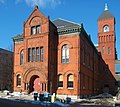Richardsonian Romanesque

Trinity Church in Boston, an exemplar of Richardsonian Romanesque style.

Richardsonian Romanesque has both French and Spanish Romanesque characteristics, as seen in the First Presbyterian Church in Detroit, by architects George D. Mason and Zachariah Rice in 1891

Architectural details of the American Museum of Natural History
Richardsonian Romanesque is a style of Romanesque Revival architecture named after architect Henry Hobson Richardson (1838–1886), whose masterpiece is Trinity Church, Boston (1872–1877), designated a National Historic Landmark. Richardson first used elements of the style in his Buffalo State Asylum for the Insane in Buffalo, New York, designed in 1870.
Contents
1 History and development
2 Architects working in the style
3 Dispersion
4 Images
5 See also
6 References
7 External links
History and development
This very free revival style incorporates 11th and 12th century southern French, Spanish and Italian Romanesque characteristics. It emphasizes clear, strong picturesque massing, round-headed "Romanesque" arches, often springing from clusters of short squat columns, recessed entrances, richly varied rustication, blank stretches of walling contrasting with bands of windows, and cylindrical towers with conical caps embedded in the walling.
Architects working in the style
The style includes work by the generation of architects practicing in the 1880s before the influence of the Beaux-Arts styles. It is epitomised by the American Museum of Natural History's original 77th Street building by J. Cleaveland Cady of Cady, Berg and See in New York City. It was seen in smaller communities in this time period such as in St. Thomas, Ontario's city hall and Menomonie, Wisconsin's Mabel Tainter Memorial Building, 1890.
Some of the practitioners who most faithfully followed Richardson's proportion, massing and detailing had worked in his office. These include:
Alexander Wadsworth Longfellow and Frank Alden (Longfellow, Alden & Harlow of Boston & Pittsburgh);- George Shepley and Charles Coolidge (Richardson's former employees, and his successor firm, Shepley, Rutan & Coolidge of Boston);
- Herbert Burdett (Marling & Burdett of Buffalo).
Other architects who employed Richardson Romanesque elements in their designs include:
Spier and Rohns and George D. Mason, both firms from Detroit;
Edward J. Lennox and John Wellborn Root, Toronto-based architects who derived many of their designs from the Richardson Style;[1]
Harvey Ellis designed in this style in Minneapolis, Minnesota.- Fenimore C. Bate designed the Grays Armory in this style in Cleveland, Ohio.
The style also influenced the Chicago school of architecture and architects Louis Sullivan and Frank Lloyd Wright. In Finland, Eliel Saarinen was influenced by Richardson.[2]
Dispersion
Research is underway to try to document the westward movement of the artisans and craftsmen, many of whom were immigrant Italians and Irish, who built in the Richardsonian Romanesque tradition. The style began in the East, in and around Boston, where Richardson built the influential Trinity Church on Copley Square. As the style was losing favor in the East, it was gaining popularity further west. Stone carvers and masons trained in the Richardsonian manner appear to have taken the style west, until it died out in the early years of the 20th century.
As an example, four small bank buildings were built in Richardsonian Romanesque style in Osage County, Oklahoma, during 1904–1911.[3]
Images
- For pictures of H. H. Richardson’s own designs and some of the details, see Henry Hobson Richardson.
With the exception of the Richardson Olmsted Complex, none of the following structures were designed by Richardson. They illustrate the strength of his architectural personality on progressive North American architecture from 1885 to 1905.
They are divided into categories denoting the various different uses of the buildings.
- Civic buildings

Minneapolis City Hall, Franklin Bidwell Long and Frederick G. Kees, architects, finished 1906

Cincinnati City Hall, Samuel Hannaford, architect, completed 1893.

Clocktower of Toronto City Hall, E. J. Lennox, architect, 1889–99: arcading and rusticated brownstone

Ontario Legislative Building, Toronto, Ontario

The Lee County, Texas Courthouse, 1899: cautious Romanesque features applied to a conservative design

Salt Lake City and County Building, Salt Lake City, Utah, Monheim, Bird, and Proudfoot architects, 1894

Brooklyn General Post Office, Cadman Plaza. Mifflin E. Bell, 1885–91
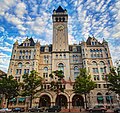
Old Post Office Building in Washington, D.C. (now Trump International Hotel Washington D.C.), designed by Willoughby J. Edbrooke, completed in 1899.
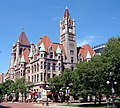
Old Federal Courts Building, St. Paul MN (now Landmark Center), (Willoughby J. Edbrooke, designed 1892, completed 1901).
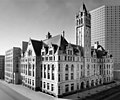
Federal Building and U.S. Courthouse, Milwaukee, WI, designed by Willoughby J. Edbrooke. Built 1892–99, extended 1929–32, renovated 1989–96.

The Barbour County Courthouse in Philippi, West Virginia, completed 1905.

Old City Hall in Fort Wayne, Indiana, completed in 1893.

Dallas County Courthouse, now Old Red Museum, designed & constructed by architect and contractor Max A. Orlopp Jr. in 1891.

McCulloch County Courthouse (Texas) in Brady, Texas, built by Martin & Moodie, completed in 1900.
Salem Superior Court, Salem, Massachusetts. Constructed in 1864 as an Italianate design, it was remodeled in the Richardsonian Romanesque style by 1889.[4]

Wayne County Courthouse (Indiana), (James W. McLaughlin, completed 1893).

Green County Courthouse, Monroe, Wisconsin, 1891.
Jasper County Courthouse, Carthage, Missouri, completed in 1895 by architect and contractor Max A. Orlopp Jr.

Statesville, North Carolina U.S. Court House and Post Office, designed by Willoughby J. Edbrooke and supervised by William Alfred Freret; now serving as Statesville's City Hall.
- Educational Institutions and Libraries
Science Hall at the University of Wisconsin–Madison in Madison, Wisconsin, designed by Milwaukee architect Henry C. Koch and completed in 1887.

Central High School (Springfield, Missouri), Springfield, Missouri, built in 1894

Lincoln School, Rock Island, Illinois, built 1893 by E.S. Hammatt, landmarked in 1984 and demolished in 2012

Old Vic, the main building of Victoria College, Toronto, built in 1892 by W. G. Storm
Altgeld Hall at the University of Illinois at Urbana–Champaign; Nathan Ricker and James McLaren White, architects, 1896-7

Pillsbury Hall, on the University of Minnesota–Minneapolis campus; LeRoy Buffington, architect, Harvey Ellis, designer, 1887

The Hugh Roy and Lillie Cullen Building on the campus of Southwestern University, built in 1898
Richardson Auditorium in Alexander Hall at Princeton University;Princeton, New Jersey; William A. Potter, architect, 1894.

Crouse College built on the campus of Syracuse University in 1881
Tolley Administration Building at Syracuse, built in 1889

Fogg Memorial Building at Berwick Academy, South Berwick, Maine, built in 1894 by George A. Clough and Hiram Fogg

The Fogg Memorial today
Orton Hall, The Ohio State University, completed 1893.

Durand Art Institute, Lake Forest College, Lake Forest, Illinois. Henry Ives Cobb architect, completed 1891.

Williams Free Library, Beaver Dam, Wisconsin. Opened 1891. Architect Walter Holbrook.

Old Chapel, former library and gathering hall of the University of Massachusetts Amherst, Amherst, Massachusetts. Architect Stephen C. Earle, completed 1887.

Acton Memorial Library, Acton, Massachusetts, Hartwell and Richardson, architects, completed 1891.
The Westminster Castle in Westminster, Colorado as it appeared on 29 May 2008

Thompson Hall at The University of New Hampshire, Durham, NH.
- Service-related buildings
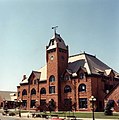
Pueblo Union Depot in Pueblo, Colorado, James A. McGonigle of Leavenworth, Kansas and Sprague and Newall of Chicago, Illinois, architects, 1889–90

The High Service Building at Chestnut Hill Water Works, Beacon Street, Boston, Massachusetts; Arthur H. Vinal, architect, 1887

Communipaw Terminal, Jersey City, New Jersey, William H. Peddle of Peabody & Stearns, architects, 1889
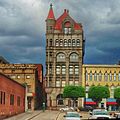
The City Bank Building (now The Professional Building) in Wheeling, West Virginia, in the Wheeling Historic District, completed in 1892. Edward Bates Franzheim, architect.

The Kirkwood Railroad Station in Kirkwood, Missouri, constructed by Douglas Donovan in 1893, and serving as an Amtrak station today.

Former Ann Arbor, Michigan train station, Spier & Rohns, architects, 1886
- Churches and chapels
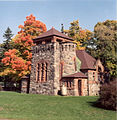
Starkweather Chapel, Ypsilanti, Michigan; George D. Mason of Detroit, Michigan, architect, 1888: Clearly articulated clustered forms in a mock-military exercise in rustication

Shadyside Presbyterian Church, Pittsburgh. Shepley, Rutan & Coolidge, architects. 1890.
First Baptist Church Beaumont, Texas, now Tyrrell Historical Library. 1903.

Pullman Memorial Universalist Church, Albion, New York, Solon S. Beman, architect. Erected 1894.

1893 building in the Richardsonian Romanesque style.

St. Thomas the Apostle Catholic Church, Ann Arbor, Michigan, 1899, Spier & Rohns, architects.
- Residences

Cupples House on the campus of Saint Louis University, St. Louis, Missouri, 1888–1890

James J. Hill House, 240 Summit Avenue, St. Paul, Minnesota. Peabody & Stearns; Mark Fitzpatrick, architects, completed 1891.

John Uri Lloyd House near the campus of the University of Cincinnati was built for a Cincinnati pharmacist by James W. McLaughlin.
George W. Frank House, Kearney, NE, designed by Frank, Bailey and Farmer, completed in 1889.
See also
- Henry Hobson Richardson
- H. H. Richardson Historic District of North Easton
- Romanesque Revival architecture
References
Notes
^ O'Brien, Marta (9 June 2008). "Toronto's Third City Hall". Heritage Toronto. Retrieved 2014-11-25..mw-parser-output cite.citationfont-style:inherit.mw-parser-output .citation qquotes:"""""""'""'".mw-parser-output .citation .cs1-lock-free abackground:url("//upload.wikimedia.org/wikipedia/commons/thumb/6/65/Lock-green.svg/9px-Lock-green.svg.png")no-repeat;background-position:right .1em center.mw-parser-output .citation .cs1-lock-limited a,.mw-parser-output .citation .cs1-lock-registration abackground:url("//upload.wikimedia.org/wikipedia/commons/thumb/d/d6/Lock-gray-alt-2.svg/9px-Lock-gray-alt-2.svg.png")no-repeat;background-position:right .1em center.mw-parser-output .citation .cs1-lock-subscription abackground:url("//upload.wikimedia.org/wikipedia/commons/thumb/a/aa/Lock-red-alt-2.svg/9px-Lock-red-alt-2.svg.png")no-repeat;background-position:right .1em center.mw-parser-output .cs1-subscription,.mw-parser-output .cs1-registrationcolor:#555.mw-parser-output .cs1-subscription span,.mw-parser-output .cs1-registration spanborder-bottom:1px dotted;cursor:help.mw-parser-output .cs1-ws-icon abackground:url("//upload.wikimedia.org/wikipedia/commons/thumb/4/4c/Wikisource-logo.svg/12px-Wikisource-logo.svg.png")no-repeat;background-position:right .1em center.mw-parser-output code.cs1-codecolor:inherit;background:inherit;border:inherit;padding:inherit.mw-parser-output .cs1-hidden-errordisplay:none;font-size:100%.mw-parser-output .cs1-visible-errorfont-size:100%.mw-parser-output .cs1-maintdisplay:none;color:#33aa33;margin-left:0.3em.mw-parser-output .cs1-subscription,.mw-parser-output .cs1-registration,.mw-parser-output .cs1-formatfont-size:95%.mw-parser-output .cs1-kern-left,.mw-parser-output .cs1-kern-wl-leftpadding-left:0.2em.mw-parser-output .cs1-kern-right,.mw-parser-output .cs1-kern-wl-rightpadding-right:0.2em
^ Johnson, Donald L. and Donald Langmead, Makers of 20th Century Modern Architecture: A Bio-Critical Sourcebook, Greenwood, 1997, p.290
^ Claudia Ahmad and George Carney (December 1983). "National Register of Historic Places Multiple Property Submission: Richardsonian Romanesque Banks of Osage County TR". National Park Service. Retrieved 2008-02-12
^ "Endangered: Historic Court Buildings". Historic Salem, Inc. Retrieved 2011-12-13.
Bibliography
- Kelsey, Mavis P. and Donald H. Dyal, The Courthouses of Texas: A Guide, Texas A&M University Press, College Station Texas 1993
ISBN 0-89096-547-1 - Kvaran, Einar Einarsson, Architectural Sculpture in America unpublished manuscript
- Kvaran, Einar Einarsson, Starkweather Memorial Chapel, Highland Cemetery, Ypsilanti, Michigan, Unpublished paper 1983
- Larson, Paul C., Editor, with Susan Brown, The Spirit of H. H. Richardson on the Midwest Prairies, University Art Museum, University of Minnesota, Minneapolis and Iowa State University Press, Ames 1988
- Ochsner, Jeffrey Karl, H. H. Richardson: Complete Architectural Works, MIT Press, Cambridge MA 1984
ISBN 0-262-15023-9 - Ochsner, Jeffrey Karl, and Andersen, Dennis Alan, Distant Corner: Seattle Architects and the Legacy of H. H. Richardson, University of Washington Press, Seattle WA 2003
ISBN 0-295-98238-1 - Van Rensselaer, Mariana Griswold, Henry Hobson Richardson and His Works, Dover Publications, Inc. NY 1959 (Reprint of 1888 edition)
ISBN 0-486-22320-5
External links
| Wikimedia Commons has media related to Richardsonian Romanesque. |
Digital archive of American architecture: Richardsonian Romanesque- Richardsonian Romanesque described and illustrated by buildings in Buffalo, New York
- Starkweather Chapel, Ypsilanti, Michigan
- Pueblo Union Depot














